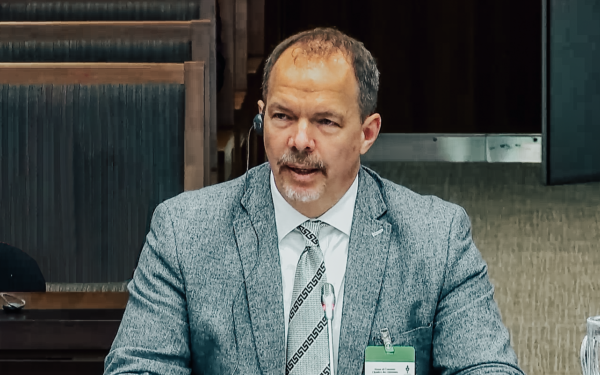CIRA’s Community Investment Program is accepting applications for its next round of grants. Rob McMahon, grant recipient and internet researcher in rural, remote and Indigenous communities shares his insights for applicants.
As you prepare to apply for funding through CIRA’s Community Investment Program, what should you be prioritizing? Which Canadian digital issues are most important for us to tackle?
We talked to Rob McMahon. He’s a past grant recipient and associate professor whose research focuses on the development, adoption and use of broadband and internet technologies by rural, remote, Northern and Indigenous communities.
Rob McMahon works at the University of Alberta’s Faculty of Extension. He is a co-founder of First Mile Connectivity Consortium, a national non-profit association which is shaping digital policy to support community broadband with remote First Nations across Canada. He is also the co-director of DigitalNWT, which uses a ‘train the trainer’ approach to equip a team of community-based instructors with the skills to offer digital literacy training in communities across the Northwest Territories (NWT).
The Community Investment Program is now open for grant applications and preference will be given to projects benefiting rural, northern and Indigenous communities.
Last year, Rob shared his insights on Canada’s digital divide and how the Community Investment Program can support projects aiming to bridge that gap.
In your opinion what is the greatest need right now in Canada’s internet?
Despite recent improvements in high-speed digital infrastructure, local connectivity remains limited and unreliable in many Indigenous, remote and northern communities, with high prices charged for services and data overage fees. This means people in these communities are losing out on opportunities in the digital economy and do not have equitable access to many of the online services available elsewhere in Canada.
To address this, we see dedicated Indigenous technicians like Bruce Buffalo in Maskwacis taking it into their own hands to improve local connectivity services in their communities. Bruce’s work is just one example of this kind of local innovation – however, we don’t know the full extent of the need in these communities. In its most recent 2019 Communications Monitoring Report, the CRTC reports that 61% of the households in the Northwest Territories can access broadband speeds of 25Mbps or higher. Given that almost half of the territory’s population lives in Yellowknife, we know be sure that many communities lack full and consistent access to broadband. We need better data and support at the community level, especially in remote areas.
How have you seen needs around the Canadian internet change over the last few years?
We’ve been seeing more interest from government and the media in the last few years on bridging the digital access divide – which is a good thing. It’s great to get more public attention on key issues affecting Canadians. To build on that, there’s now a need for open, accessible data and a fair playing field for all providers. For example, the Auditor General of Canada pointed out in its Fall 2018 report on connectivity in rural and remote areas that small internet service providers did not have sufficient access to high-quality spectrum to support broadband deployment in rural and remote areas. This means there’s less competition for internet service providers in these areas so the price goes up. This is despite the fact that spectrum licensees are not even using (or leasing) spectrum they hold, partly because there is little business incentive to make unused spectrum available for subordinate licensing.A close-up up of the “Make the net-work” 3D model, which illustrates how a community network is set up. The team developed customized versions of this model for the four Gwich’in communities, part of Rob’s digital literacy project funded by the Community Investment Program. Image credit: Hanne Pearce.
What other needs stand out for you?
While it’s good that people learn how to code and build websites, we also need to help people monitor their internet service. We should encourage digital literacy around how to test an internet connection to ensure people are getting what they pay for. People need to know how to report things like high data overage fees, so that regulators are aware what they are paying – particularly in areas with subsidized coverage. Digital literacy should pay attention to internet infrastructure as well as applications.
Our 2018 CIRA funded project – Digital literacy learning and resources with Gwich’in Tribal Council – demonstrates one way to build community-based internet monitoring into digital literacy programs. Our team has worked to explore innovation in Gwich’in contexts through workshops and the creation of open educational resources in the Northwest Territories. Since the conclusion of that project, we have continued to work with our northern partners through the DigitalNWT project (funded by Innovation, Science and Economic Development Canada), which is developing customized digital literacy curriculum that people in NWT communities can teach and update on an ongoing basis.
Another CIRA-funded project I’m involved in with three First Nations organizations and Cybera is evaluating internet speeds in Indigenous communities across Manitoba, Alberta and BC, and will share our methodology so other groups can also do so.
Internet infrastructure and digital literacy are two of the funding areas for CIRA’s Community Investment Program. This year, CIRA is especially looking for projects benefitting rural, northern, and Indigenous communities.
CIRA is now accepting grant applications for innovative internet projects. Apply for a grant at www.cira.ca/grants until February 25, 2020.
Erica works in corporate communications at CIRA. Her background is in writing and community relations in the non-profit sector. She is a graduate of Carleton University’s journalism program.




